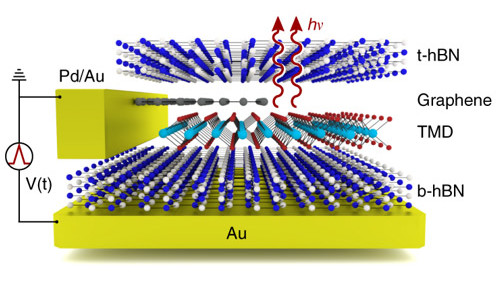LED Glows at Different Colours
April 23, 2019
on
on

A research team at the Vienna University of Technology has built a new type of LED that generates light with the help of excitons.
When extremely thin layers of tungsten and selenium or sulfur are stimulated with electrical pulses it produces ‘multi-particle exciton’ clusters. These clusters are bonding states made up of electrons and holes and can emit light. This novel LED structure allows the wavelength of the light to be controlled with great precision by controlling the applied voltage pulses.
Under certain circumstances, combinations of holes and electrons can form a bond with each other. Similar to how an electron orbits a nucleus in a hydrogen atom an electron can also orbit a positively charged hole in a solid material structure. There are even more complex bonding states possible such as trions, biexcitons, or quintons, where three to five bonding partners are involved. A Biexciton would, for example correspond to the exciton equivalent to the hydrogen molecule H2.
Since the binding energy of the excitons in such a thin layered structure is much higher than in conventional solids, the excitons are more stable. The bonding states can even be shown to occur at room temperature. At lower temperatures larger and more complex exciton clusters can be detected. Different exciton complexes can be generated depending on the characteristics of the applied voltage pulses. When these complexes decay, energy is released in the form of light. The wavelength of the light emitted is determined by the characteristics of the electrical pulse applied.
The research findings are published in the journal Nature Communications with the title Electroluminescence from multi-particle exciton complexes in transition metal dichalcogenide semiconductors.
When extremely thin layers of tungsten and selenium or sulfur are stimulated with electrical pulses it produces ‘multi-particle exciton’ clusters. These clusters are bonding states made up of electrons and holes and can emit light. This novel LED structure allows the wavelength of the light to be controlled with great precision by controlling the applied voltage pulses.
Excitons clusters
Electrons moving through semiconductor material from one atom to another is how a (negative) charge passes through a semiconductor material. It can also be that an electron is absent at some position in the material leaving a (positively charged) ‘hole’. When a charge is applied and an electron moves to fill the hole it leaves a positively charge hole in the position it just vacated. Holes therefore flow through the material much like electrons but in the other direction.Under certain circumstances, combinations of holes and electrons can form a bond with each other. Similar to how an electron orbits a nucleus in a hydrogen atom an electron can also orbit a positively charged hole in a solid material structure. There are even more complex bonding states possible such as trions, biexcitons, or quintons, where three to five bonding partners are involved. A Biexciton would, for example correspond to the exciton equivalent to the hydrogen molecule H2.
Layered 2D materials
In most materials such states are only possible at very low temperatures just above absolute zero. In ‘two-dimensional materials’ where the layers of material are just one atom thick, things behave differently. The research team at the Vienna University of Technology produced a structure consisting of a thin layer of tungsten diselenide or tungsten disulfide sandwiched between two layers of boron nitride. Using graphene electrodes, they applied an electrical signal across this layered structure.Since the binding energy of the excitons in such a thin layered structure is much higher than in conventional solids, the excitons are more stable. The bonding states can even be shown to occur at room temperature. At lower temperatures larger and more complex exciton clusters can be detected. Different exciton complexes can be generated depending on the characteristics of the applied voltage pulses. When these complexes decay, energy is released in the form of light. The wavelength of the light emitted is determined by the characteristics of the electrical pulse applied.
The research findings are published in the journal Nature Communications with the title Electroluminescence from multi-particle exciton complexes in transition metal dichalcogenide semiconductors.
Read full article
Hide full article


Discussion (0 comments)